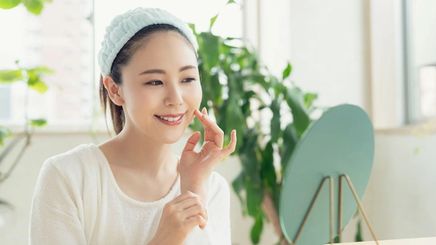
Acne can be incredibly frustrating, and the search for proper treatments is often grueling. Still desperate for something that can banish your ? Try retinoic acid. If you’ve never heard of it, give it a chance – it’s one of the most effective methods for managing and preventing pesky pimples.
Retinoic Acid vs. Retinol: What’s the Difference?
Before getting into what it is, you should know where it comes from. and retinoids are often confused as the same. Although both ingredients are chemically similar and treat similar conditions, they have distinct differences. Retinol is a type of retinoid, a.k.a. any compound derived from retinyl palmitate (vitamin A).
Retinoids in skincare products are categorized under retinol, retinyl esters, retinaldehyde, and retinoic acid. Retinoic acid also goes by the name “tretinoin,” so keep that in mind when researching formulas. It’s an active form of retinol and is absorbed by the skin immediately, while retinol must be converted (first to retinal, then retinoic acid)before it can take full effect.
As a topical acne treatment, tretinoin is most commonly used to treat acne and other skin flare-ups, such as psoriasis. Unlike pimple patches and fast-acting solutions, tretinoin is no overnight miracle. You must use it consistently for an extended period before seeing noticeable results.
Retinoic Acid for Acne Scars and More
A described tretinoin as a mainstay for acne treatment because of its anti-inflammatory effects. Since it’s derived from vitamin A, it also stimulates cell turnover. Fewer dead cells on the skin mean less noticeable scarring and minimal acne-causing buildup to worry about. Tretinoin also reduces the size of hair follicles in the skin, which regulates sebaceous glands and prevents excess sebum secretion.
Other Benefits of Retinoic Acid
Beyond treating acne and its side effects, tretinoin offers several other benefits. The long list includes its anti-aging perks. shows that tretinoin can stimulate production, making fine lines and wrinkles less visible. It helps improve discoloration, even skin tone, and smooth skin texture.
How to Use Retinoic Acid
Tretinoin comes in gel or cream form and is generally easy to use. However, there are precautions you must take. Follow these steps to minimize the risk of irritation and other adverse effects.
Step 1: Cleanse.
Before applying the tretinoin, make sure your face is clean. For a thorough cleanse, use the POND'S Bright Miracle Ultimate Acne Control Facial Foam. It's formulated with Active Thymo-BHA Essence (the world's first!) and vitamin B3+ (niacinamide) to help reduce excess oil and acne-causing bacteria.
You can also try Eskinol Pimple Relief Facial Wash, which is infused with cica from Korean and green tea extracts, making it suitable for sensitive skin.
Step 2: Treat.
After washing and drying your skin, apply a small amount of your treatment to the affected areas. When using tretinoin for wrinkles, focus on any visible fine lines instead of the entire face.
Step 3: Moisturize and protect.
Apply moisturizer before and after acne treatment to avoid irritation. If you plan on using tretinoin during the day, layer it with plenty of . Your skin will be extra sensitive during the first weeks of using a tretinoin treatment so it will be more prone to sun damage.
The Potential Side Effects of Retinoic Acid
You may experience side effects from your retinoic acid prescription. Since it’s a medication designed for long-term use, it may take several months before you start seeing results. In one , patients who were given a combination of tretinoin cream and clindamycin 1% gel saw a reduction in facial acne after 12 weeks of treatment. Results could come sooner or later, depending on the severity of the case.
In some cases, your acne might even get worse before it gets better. This is your skin going through a phase and it’s perfectly normal. Other common side effects include:
- Red, irritated, and scaling skin
- Warmth or a stinging/burning sensation
- Dryness, peeling, redness, or flaky skin
- Lightening or darkening of skin
- Increase in acne lesions
- Swelling, blistering, or crusting
But if you feel like you’re experiencing complications that are out of the norm, stop the treatment and consult your dermatologist to adjust your dosage. If you’re pregnant or breastfeeding, it’s best to avoid tretinoin altogether.
As an alternative, try Eskinol Pimple Relief Serum. Infused with cica and green tea extracts, it helps soothe troubled skin. Apply 3-4 drops and spread evenly over the face.
Tretinoin may not be for everyone, but that doesn’t mean all hope is lost if it doesn’t work for you. Other retinoid-like treatments, like salicylic acid or benzoyl peroxide, are milder alternatives that are worth trying if tretinoin proves too harsh. Talk to your derma to find a workaround.
Does retinoic acid (tretinoin) help treat acne-prone skin? The answer is a resounding yes with long-term, consistent use and precautions. Trust the healing process and give your skin enough time to adjust.